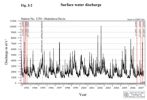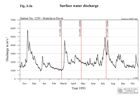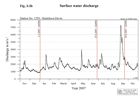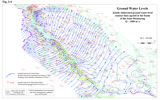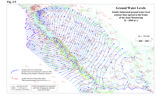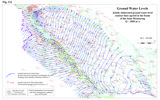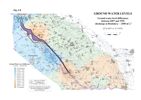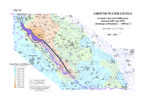PART 3
Ground Water RegimeThe impact of temporary technical measures and discharges into the Danube and the Mosoni branch of the Danube, realised according to the Agreement, and the impact of the water supply on the ground water regime and ground water levels in the hydrological year 2007 was monitored by 263 (136+127) observation wells on the Slovak and the Hungarian territories. These monitoring objects are situated in the area of ®itný ostrov and in the Szigetköz region. List of observation wells is given in National Annual Reports on environmental monitoring respectively. According to the Minutes from meeting held by the Monitoring representatives on April 25, 2007 the Hungarian Party significantly changed the observation network, however the number of observed wells remained unchanged. The situation of the observation networks on both sides is shown in Fig. 3-1. The evaluation of ground water level data in 2007 in a local scale was done by the Parties themselves and is given in National Annual Reports. The jointly elaborated regional evaluation given in this report was prepared according to the jointly constructed groundwater level equipotential lines. The equipotential lines were constructed for comparison of the groundwater levels in the influenced area in the current year and the groundwater levels before construction of the bottom weir and introducing the water supply into the river branches on Hungarian side. 3.1. Joint evaluation of ground water regimeGroundwater levels in the observed area are primarily influenced by the surface water levels in the Danube and reservoir. The regime of the Danube in the hydrological year 2007 was atypical. The average daily values during a greater part of the year fluctuated below the long-term average values. More significant increase of discharge occurred in the second half of January, in March, May and July, and in September a flood wave occurred culminating at 7550 m3s-1. The low water period on the Danube prevailed from the beginning of hydrological year 2007 and lasted till the second half of January 2007. However the short discharge wave had almost no influence on groundwater levels. As a consequence of this the groundwater levels remained low till the end of February. The groundwater level increase started in March. Due to lack of significant discharge or flood waves the increase was moderate and the groundwater levels lagged behind the levels registered in the previous year. Significant influence on groundwater level had the flood wave in September 2007. It substantially contributed to the recharge of the soil layers, but it had low importance from the vegetation point of view. Concerning the atypical course of discharges the minimal groundwater levels depending on the distance of observation well from the Danube occurred during the whole hydrological year. However, at wells relatively close to the Danube the minimums occurred at the end of the winter period. The yearly maximal levels on these objects occurred during the flood wave in September. With increasing distance of observation well from the Danube the fluctuation appeared with delay or in case of smaller discharge waves did not occurred at all. The groundwater regime at distant observation wells reflected to a great extent other conditions (e.g. climatic conditions, surface or groundwater levels on boundaries). Regarding the yearly groundwater level fluctuation lower values were reached as well in comparison with the previous year. In the upper part of the observed territory and in the inland area the ground water level fluctuation ranged from 0.3 to 2.8 m, at the vicinity of the reservoir maximally up to 0.9 m. In the lower part of inundation area the fluctuation reached 3-6.5 m. At the end of hydrological year the position of ground water levels returned approximately to the state registered at the beginning of the hydrological year. For computing the ground water level differences three hydrological situations were chosen in the period before and after introducing the water supply. The selected hydrological situations characterise the low, average and high flow rate conditions in the Danube, corresponding to flow rates approximately 1000, 2000 and 3000 m3s-1. The selected dates and the corresponding flow rates in the Danube at Bratislava-Devín gauging station are the following (Tab. 3-1, Fig. 3-2, Fig. 3-3a, Fig. 3-3b): Table 3-1
Low flow rate period was chosen at the beginning of January 2007. The average flow rate period was chosen at end of June, in a comparable hydrological situation as the period chosen in 1993. The high flow rate period was chosen at the beginning of third decade of September 2007 on the descendent branch of the previous flood wave, when the average discharge fluctuated around 3000 m3s-1. In this case the hydrological and meteorological situation was not comparable with the situation in 1993, but no better one occurred in 2007 due to atypical discharge regime. Maps of equipotential lines were jointly constructed for the selected dates using the measured ground water levels (Figs. 3-4 to 3-6). In wells where the water level is measured once a week, the ground water level for the selected dates was computed by linear interpolation. In all other wells the daily average values were used. The altitudes of the ground water levels are given on maps for each observation object used for the equipotential line construction. For constructing equipotential lines computed surface water level data in the Danube was used as well. This level was computed by a calibrated model, using river morphology data and measured water levels data on a given stretch. The other surface water levels were not used for constructing the equipotential lines. The constructed equipotential lines represent general ground water levels and flow direction, and do not show the local influences of the channels or river branch systems. Differences between ground water levels for selected hydrological situations in years 1993 and 2007 are expressed in Figs. 3-7 to 3-9. The evaluation is mainly focused on the area influenced by the technical measures and discharges according to the intergovernmental Agreement and by the water supply realised on the Hungarian side. In this sense the inundation and the flood-protected area on the Hungarian side, and partly the inundation area on the Slovak side, represent the influenced area. Low flow rate conditions Comparing the low water hydrological situations (approximately 1000 m3s-1) in periods before and after realising the technical measures and releasing discharges according to the Agreement (2007 versus 1993), it can be stated that, in consequence of water supply into the right side river branch system and into the Mosoni Danube and partially the increased water level in the Danube old riverbed, on large part of the influenced area increase of ground water levels occurred, both on the flood-protected area and the inundation area as well (Fig. 3-7). The ground water level increase in the upper part of the Szigetköz area between Rajka and Dunasziget is reduced by ground water level decrease in the area around the reservoir caused by decrease of permeability of the reservoir bottom in between the compared periods. In the middle part of the Szigetköz area between Dunasziget and Lipót, higher ground water levels were created at low flow rate conditions as a response to the water supply of the river branch system and inland channels. An increase in the ground water level also occurred along the upper part of Mosoni Danube. In the lower part of the Szigetköz, downstream from Ásványráró and around the Bagoméri river branch system the ground water levels were slightly lower than in 1993. Lower ground water levels were recorded on the left side of the reservoir, in the upper part of the ®itný ostrov as well, due to the big difference in the permeability of the reservoir bottom. However, the ground water levels at present are much higher than before constructing the dam. For an overall evaluation of impacts in the influenced area similar comparison for periods before constructing the dam and the present time would be required. Significant decrease in ground water levels occurred along the tailrace channel and downstream the confluence of the tailrace channel and the Danube old riverbed. The riverbed erosion influences this region. On a large part of the Slovak side there were no changes in ground water levels observed. In general the increase of ground water levels is about 0.2-0.75 m in comparison to ground water levels in 1993. This occurs mainly in the area affected by water supply realised on the Hungarian side. There is an increase of ground water levels in the inundation area on the Slovak side as well, which is evoked by the water supply on the Slovak side, however this is independent on measures according to the Agreement. The ground water flow direction in the upper part of the river down to Dunakiliti shows infiltration from the river and the reservoir into the surrounding area. Along the Danube from Dunakiliti down to the confluence with the Mosoni Danube the ground water flows into the riverbed and the river is draining the adjacent area, but the ground water in the inland area is flowing parallelly with the Danube. In the lower part of ®itný ostrov area Danube, together with the Váh river are draining the area. Average flow rate conditions Comparing the ground water levels in the period before realising the technical measures, after increasing the discharges into the Danube according to the Agreement, and after introducing the water supply on the Hungarian side, at average flow rate conditions in the Danube (approximately 2000 m3s-1), the result is similar to that at low water conditions. A significant increase in the ground water levels occurred in both the upper and middle part of the Szigetköz area and along the Mosoni Danube. The ground water level increased about 0.3-1.7 m (Fig. 3-8). The most significant ground water level increase occurred in the middle part of the Hungarian inundation area, where it reaches 0.7-1.7 m. Compared to 1993, the ground water levels along the Danube in the lower part of the Szigetköz (at the mouth of Bagoméri river branch system) were slightly lower. The decrease of ground water levels is caused by riverbed erosion in this Danube stretch. On the Slovak territory no impact from the technical measures according to the Agreement appears. Higher ground water levels in the left side inundation area reflect the different water supply regime in the river branch system in 1993 and 2007. A decrease in the ground water levels can be observed around the left side of the reservoir. This results from a lower water level in the reservoir than in 1993 and a decrease in the permeability of the reservoir bottom as well, but in general the ground water levels are higher than before damming the Danube. On a large part of the Slovak side there were no changes in ground water levels observed. The ground water flow direction in the upper part of the river down to Dunakiliti shows infiltration from the river and the reservoir into the surrounding area. Along the Danube from Dunakiliti down to the Gabčíkovo the ground water flows into the riverbed and the river is draining the adjacent area, but the ground water outside the inundation is flowing into the inland area. In the lower part of ®itný ostrov area the Danube supplies the adjacent area and the ground water is drained by the Váh. High flow rate conditions When comparing the high flow rate conditions in the Danube (approximately 3000 m3s-1) for the period before (1993) and after (2007) realising the measures according to the Agreement, a decrease in the ground water levels can be seen along the Danube. In the evaluated year and in the compared period the ground water level in the section between Dunasziget and Dunaremete show negligible changes against the period in 1993 (Fig. 3-9). The decrease in the upper and lower part of the inundation area mainly reaches 0.1-0.8 m. This difference is partially caused by the difference in the discharges released to the Danube old riverbed in 1993 (1020 m3s-1) and in 2007 (510 m3s-1). On a great part of the flood-protected area in Szigetköz there is an increase of the ground water levels, which is caused by the water supply in the Mosoni Danube, the inland channel system and by higher ground water levels on the examined area boundaries. The decrease in the ground water levels on the left side of the reservoir are related to lower water level in the reservoir comparing to the 1993 and decrease in the permeability of the reservoir bottom. In the middle part of the ®itný ostrov area no change is documented. The increase in the lower part of ®itný ostrov area is connected with the surface water regime in the channel system. The ground water flow directions along the Danube, except the upper and middle part of the inundation, show water supply from the Danube into the adjacent area. 3.2. ConclusionsBased on the evaluation of the ground water regime it can be stated that the water supply into the right side river branch system plays an important role in influencing ground water levels over the Szigetköz region. As a result of the measures realised according to the intergovernmental Agreement, a significant increase in the ground water levels occurred for low and average flow rate conditions in the Danube. A decrease in the ground water levels along the Danube riverbed can be registered for the high flow rate conditions, however in some distance from the Danube old riverbed no change was observed in inundation area and increase of ground water levels in the inland area of Szigetköz. The monitoring results highlights the necessity to solve the water supply in the lower part of the inundation area on both sides. The ground water level increase in the lower part of the Ásványi river branch system and in the Bagoméri river branch systems and on the Istragov island on the Slovak side could be solved also by measures applied in the Danube old riverbed upstream of the confluence with the tail race channel. Such measures can improve the general situation in this region. An increase of ground water levels in the strip along the Danube old riverbed on both sides could be ensured only by increase of water level in the Danube by measures realised in the riverbed. The most simple, quickly realisable measure seems to be the solution applied at Dunakiliti at rkm 1843, realised according to the “Agreement”. An overall evaluation of impacts in the influenced area based on the comparison of periods before constructing the dam and the present time would be required.
|
||||||||||||||||||||||||

